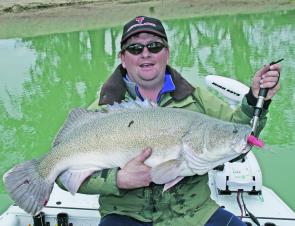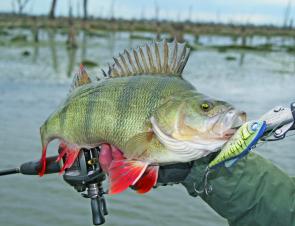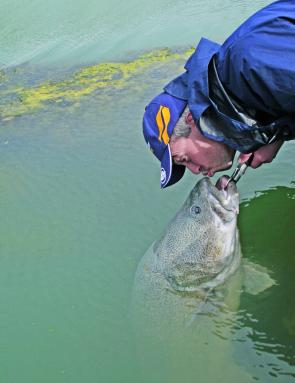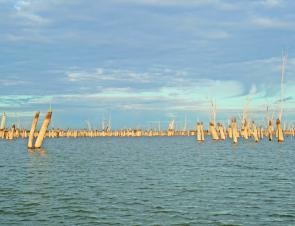Lake Mulwala has a deserved reputation as the best Murray cod fishery in Australia. No other water comes close to producing Murray cod with such consistency and in such numbers as Lake Mulwala. Recent seasons have been the best ever and it is great to see the growing trend of anglers practising catch and release so that the fishing will continue to improve.
Located 215km north of Melbourne, Lake Mulwala is popular with southern anglers but also draws would-be cod fishers from all around the country. At a huge 4,450 hectares and with over 43km of shoreline, however, many anglers simply don’t know where to start. Hopefully this article will take away some of the mystery and encourage more anglers to come and have a crack at catching an Aussie icon.
The most popular species targeted by anglers in Lake Mulwala are Murray cod and golden perch. The average-sized Murray cod caught by anglers is between 50-62cm. Larger specimens measuring over the magical 1m mark are also caught and released each year. The average-sized golden perch is around 40cm.
The 2008 season has seen increasing numbers of redfin caught, which have provided good sport and a tasty meal for anglers wanting to practice catch and release with the native species. In 2008 the lake’s water clarity has been good and large volumes of weed is prevalent in the lake. This has provided ideal conditions for the redfin. It will be interesting to see whether the trend continues in the 2009 season.
There is also a large population of European carp present in the lake. These noxious pests do provide good sport for anglers, but must be removed from the waterway if caught.
Anglers target these species using a range of techniques. It was not that long ago that bait fishing was the most productive method. The most popular baits for fishing Mulwala are bardi grubs, yabbies, shrimp, worms and cheese. In recent years, however, there has been a huge increase in anglers targeting these fish with lures.
Many different styles of lures are effective on Murray cod and golden perch. Several years ago trolling hardbodied lures in the deeper channels was the preferred technique. Recently, increasing numbers of anglers concentrate on fishing the shallow areas by casting and retrieving lures. Spinnerbaits, lipless crankbaits, hardbodied lures, soft plastics and surface lures are all productive.
The majority of carp are caught on bait, with worms, maggots and corn being the most popular.
As a guide on Lake Mulwala, I am commonly asked which are the best areas to fish, or where the secret spots are. The simple answer is that there are no secret spots. The whole lake holds a good population of fish, so it doesn’t really matter which area you choose. Within any particular area, however, there are a number of key factors that anglers should look for to improve their catch rates.
Firstly, try and fish areas that receive reduced fishing pressure. It is commonsense that if an area has seen less fishing then the resident fish are less likely to have been caught before.
Secondly, try to fish areas where there are signs that may indicate an increased population of fish. For starters, look for places with an increased amount of bait present. Mostly this is where there is suitable habitat in the form of weed beds and fallen timber.
You should also concentrate your fishing effort in a suitable depth, where greater numbers of fish are holding. The depth at which fish are holding varies greatly depending on the time of the year. Early in the season the greatest concentrations of fish are usually found in shallow water and depths of 1-2m can very productive. The shallow water is often a lot warmer earlier in the season, which helps attract both bait and predators into the shallow margins.
During the hotter times of the year, the fish are more evenly spread, with both shallow and deep water holding good number of fish. Then during the coldest months of the year, the highest concentrations of fish are often found in the deeper water.
Next, try and fish an area of the lake where you can fish effectively. Wind strength and direction are be a major consideration of mine when determining the area of the lake in which I will concentrate my fishing effort. The lake has a number of boat ramps located around the perimeter of the lake.
Current flow is a huge factor in increasing your chances of success when targeting native fish. Murray cod and golden perch are both ambush feeders. They often prefer to lay and wait for the current to bring food to them, then they ambush it as it swims past. Rarely are they actively swimming around in open water chasing down food sources.
The majority of current flow comes down the bed of the Murray River, which runs through the lake. There are, however, several smaller creeks that produce current flow in the lake. The top section of the lake around Majors Boat Ramp is where the current is greatest. The lake gets deeper as you get closer to the weir and at this end the current flows are reduced.
There are a number of top areas where new anglers could commence their angling efforts. One is the pooled water located near the township of Yarrawonga and Mulwala. To the uneducated angler this area may not look very appealing. When the lake was first built large volumes of timber were felled and some were removed from the lake. There are, however, still large amounts of timber lying on the lake’s bottom. When the timber was felled a lot of the stumps were pushed into the river courses. These clusters of timber are perfect locations to target native fish. In this area, trolling the edges of the river course is the preferred tactic but there are some good casting areas around the edges of the lake too.
Kyffin Reserve is another area that has become increasingly popular in recent years. In this area the majority of water is shallow. This area often has a good amount of weed growth and water clarity can be a little better. This area is popular with anglers casting and retrieving lures. Because of the increasing amount of fishing pressure this area has received in recent years, anglers need to think outside the square as the most obvious structure receives a lot of fishing pressure. The less obvious structure still consistently produces fish.
The Woodlands area is located in the centre of the lake. This has a mixture of some very good trolling and casting areas.
Majors is located at the top end of the lake and it has a good mixture of both good trolling and casting areas.
The Everglades in the top section of the lake is popular with those anglers who like casting into shallow areas.
Bundalong is where the Ovens and the Murray rivers meet. They then run several kilometres down into the lake. This area is popular with bait fishers and anglers trolling lures. This area provides the best protection during windy days.
The majority of anglers fishing Lake Mulwala for the first few times find it a very challenging and daunting experience. Lake Mulwala is full of thousands of dead trees. The sheer volume of timber can make it very confusing for anglers new to the lake. The key to increased catch rates is to concentrating on higher percentage areas.
‘Lay me downs’ are trees that have fallen over and are lying horizontal. These provide ideal habitat and cover for fish. They are consistent producers and are the most popular form of structure targeted by anglers casting and retrieving. The larger the lay me down, the higher the percentages that it may hold fish.
‘Uprights’ are trees that are still standing in the lake. Uprights receive reduced fishing pressure however they do hold good concentrations of fish. There are a few factors that increase your chances of catching a fish off an upright; if the upright is located close to the edge of a creek or river and has increased current flow; if the upright has had soil washed away from the base of the tree; if the tree has branches that have been washed up against the tree trunk; if the upright tree is hollow. All these factors provide good habitat for resident fish.
‘Soft vegetation’ occurs in the lake in a number of different forms. Weed beds are the most common form of soft vegetation, and they are often the most neglected by fishers. Weed beds provide great habitat and are often consistent areas to fish. The most productive weed beds are those that are located on the edges of a river or creek.
There are a number of locations around the lake’s edges where willow trees are growing. The willow trees provide great structure and shade for resident native fish. The most productive willow trees are adjacent to the rivers edge. These willow trees will have good current flow passing. They often have other good structure such as large logs that have been pushed into these areas by the wind and current flow.
Cumbungi is also present in the lake and around the shoreline of the lake. There is a couple of ‘cumbungi islands’ in the lake. These are good locations and good numbers of golden perch and Murray cod are caught in these areas each year.
‘Sub-surface structure’ occurs in the lake in many different forms. The most popular is the timber that is in the deeper sections of the lake or river course. Anglers effectively target these areas by bait fishing or trolling. Ledges or drop-offs are areas where rapid changes in depth occur. These are usually because of a river course or creek or a lagoon. Where ever this scenario occurs fish will often be caught adjacent to the change in depth.
So, now that the Murray cod season is upon us, why not plan a trip to Lake Mulwala? There’s no better place to catch a Murray cod – even if it’s your very first!
Facts
ACCOMMODATION
There is a large variety of accommodation available at Lake Mulwala. Some options are:
Sun Country Holiday Village, 03 5743 1074
Shoreline Caravan Park, 03 5744 1458
Yarrawonga Holiday Park, 03 5744 3420
Lakeside Caravan Park, 03 5743 2888
Lake Mulwala Holiday Park, 03 5744 1050
Ski Land Motel, 03 5744 3937
Murray River Motel, 03 5744 1245
Capricorn Motor Inn, 03 5744 3813
Paradise Palms Motel, 03 5743 2555
For further information contact the Yarrawonga-Mulwala Information Centre on 03 5744 1989.
Facts
BOAT RAMPS
Lake Mulwala has many good boat ramps. Some of the most popular ramps are:
Majors Boat Ramp, which is located at the top of the lake off Wrights Road. This ramp was upgraded a couple of years ago and has a good parking area.
There are a couple of boat ramps at Bundalong, with the one at Pyke Street being the most popular.
The boat ramp at Woodlands area is located of Buchanans Road. This is only a shallow ramp and launching can be difficult here if the lake is low. It also has a limited parking area.
There is a boat ramp located off Hogans Road. This is a good steep ramp and has a good parking area.
In the township of Yarrawonga there are several popular boat ramps. A ramp is located at the yacht club off River Road. Another boat ramp is located off Bank Street next to the Yarrawonga water slide.
In Mulwala there are boat ramps at the Mulwala Water Ski Club. Another boat ramp is located next to the Mulwala water slide. Other ramps are located in the park next to the steam train off Melbourne Street. A boat ramp is also located opposite Lakeside Caravan Park on Corowa Road.
Facts
COD HUNTER FISHING TOURS
For further information, contact Roger Miles at Cod Hunter Fishing Tours on 0427 483 286, or email --e-mail address hidden--
Cod Hunter Fishing Tours target native fish species with lures only, in Lake Mulwala, the Murray River downstream to Torrumbarry Weir, and local waters around Bendigo such as the Loddon and Campaspe rivers.
Tours are conducted in Roger’s 4.7m Savage Jabiru boat, which has forward and rear casting decks and is powered by a 50 hp 4-stroke outboard. It also has an electric motor for extra stealth when casting into snags.
A full day tour usually lasts 10 hours. All gear, including rods, reels and lures, is supplied on a ‘replace if lost’ basis. Lunch and tea/coffee is supplied, and anglers can be picked up from their accommodation.
Facts
LAKE MULWALA
Lake Mulwala is a weir on the Murray River that was first filled in 1939. Today it supplies two major irrigation channels, the Yarrawonga Main Channel on the Victorian side and the Mulwala Canal on the New South Wales side. Together these channels service over 800,000 ha. The lake is 1992 km from the Murray mouth, has an area of 4450 ha, and a storage capacity of 118 gigalitres.

This is what Lake Mulwala is all about: big cod on lures. No other waterway in Australia comes close to producing Murray cod with the consistency that Mulwala does.

Casting lures around the snags – especially early in the morning or in the evening – is a pleasant and productive way to fish Lake Mulwala.

Redfin provide good sport and a tasty meal for anglers wanting to practice catch and release with the native species. They have become more prevalent in Lake Mulwala over the last year or two.

Most regular cod anglers develop and deep respect for their quarry. Practising catch and release is a good way to ensure the great fishing in Lake Mulwala continues in years to come.

Careful handling of big Murray cod is vital to ensure their survival after release.

When a big Murray cod inhales your lure and takes off with it, you’re in for one of the most exciting freshwater fishing experiences in Australia.

Many anglers find the massive amount of timber in Mulwala very daunting. The whole lake holds fish though, so the secret to success is not so much where you fish but how you fish.

Golden perch are a popular target in Lake Mulwala and have the advantage that they can be legally targeted during the closed season for cod.




